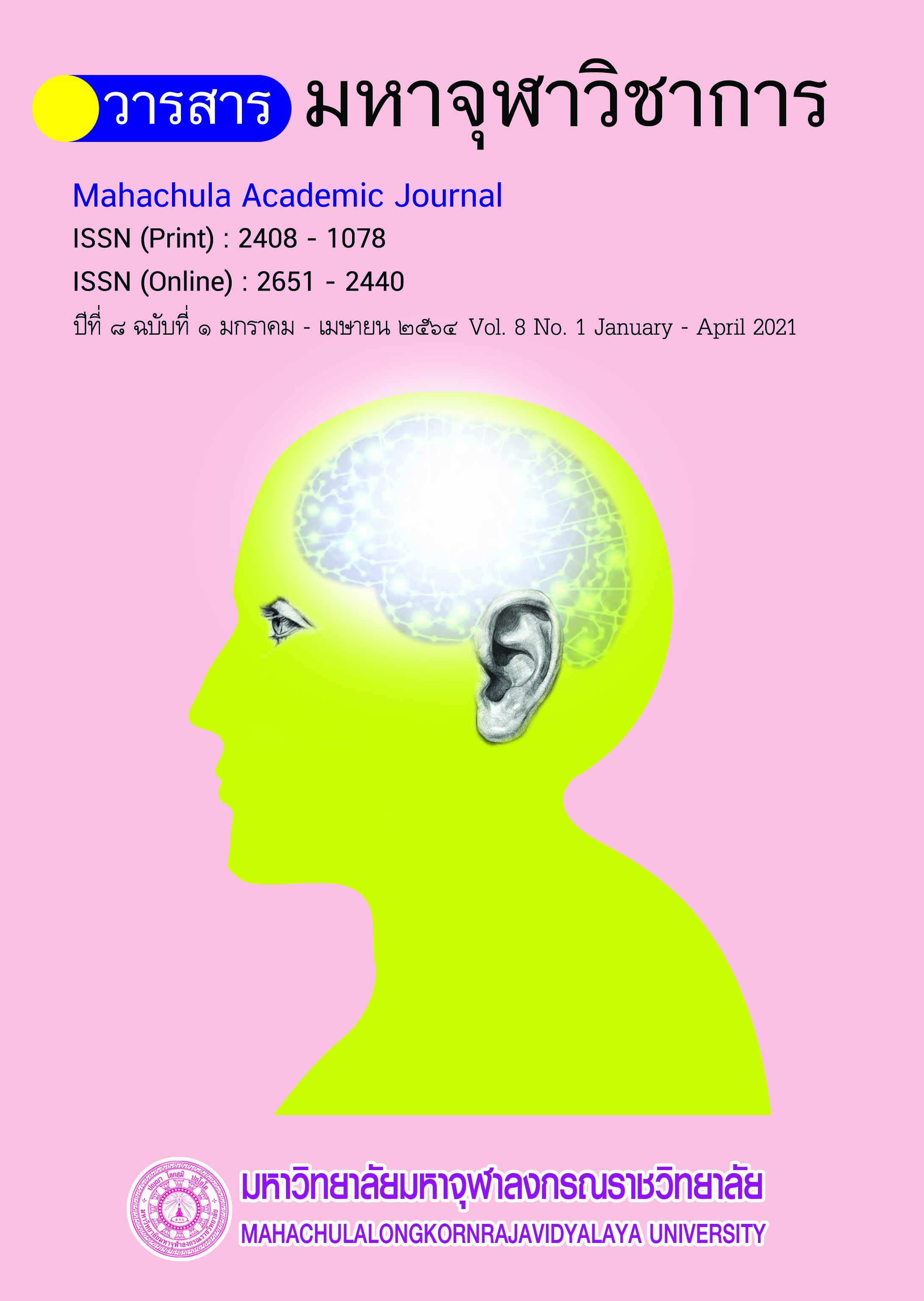Aesthetics of Buddhism on Tai Dam woven fabric pattern
Main Article Content
Abstract
Aesthetics of Buddhism on Tai Dam woven pattern is an expression of the concept of beauty that values of goodness and the truth as it appears on the woven fabric pattern, which is a distinctive characteristic of the Tai Dam culture. Which is based on beauty based on the ethical values of 2 levels which are
1. Abstract beauty Emphasize the beauty of Buddhism, including principles of life. Considered a high level of beauty, such as the law of nature the truth of life and the way to end suffering called Noble Truths Principle 4, Law of Karma, Law of Trinity, Trinity of Practice 4, Sangahavatthu 4, Brahmavihara 4, Aprihanigadhamma 7, Saraniyadhamma 6, Sacrifice principles 5. Directions 6, Mangala 38, Principles of Reclusion, Principle of Reclining, Pilakkhama, Honest, Patience, Tolerance, Unity, Humility, Generosity, Sacrifice, Kindness, Mercy Discipline, Comprehension, Self-reliance, which is reflected through the pattern on the woven fabric, namely, species of flora, animal patterns, patterns of things. And patterns, utensils
2. Beauty in concrete levels is a shape beauty and the beauty of the environment that the creator had invented on woven fabric, including the fabric patterns of flora, animal patterns, patterns of things and patterns, utensils. There are decorated with looking glass fabric that has the characteristics of various patterns. That has the meaning consistent with the way of life of the Tai Dam which is related to Buddhism. The decoration of the mirror and the coloration reflecting the emotional feeling and communicate in accordance with the Buddhist principles, namely, indigo, dark or black, yellow, orange, green, red or crimson, white.
Article Details
References
กฤษฎา ดิษบรรจง. “กระบวนการให้ความคุ้มครองด้านลิขสิทธิ์ในภูมิปัญญาพื้นบ้านและอัตลักษณ์ลวดลายผ้าของกลุ่มชาติพันธุ์ไทยทรงดำ จังหวัดสุพรรณบุรี”. วิทยานิพนธ์ปรัชญาดุษฎีบัณฑิต สาขาวัฒนธรรมศาสตร์. คณะวัฒนธรรมศาสตร์: มหาวิทยาลัยมหาสารคาม, ๒๕๕๘.
กานต์ทิตา สีหมากสุก. วิเคราะห์ปัจจัยการดำรงอยู่และการเปลี่ยนแปลงความเชื่อในพิธีกรรมของไทยทรงดำ: กรณีศึกษาเขตตำบลหนองปรง อำเภอเขาย้อย จังหวัดเพชรบุรี. ชลบุรี: คณะมนุษยศาสตร์และสังคมศาสตร์ มหาวิทยาลัยบูรพา, ๒๕๕๘.
จิตรลดา เกิดเรือง. “การพัฒนาหลักสูตรสถานศึกษา เรื่อง ประเพณีและพิธีกรรมไทยทรงดำ สำหรับนักเรียนชั้นประถมศึกษาปีที่ ๕ จังหวัดสุพรรณบุรี”. ภาควิชาหลักสูตรและวิธีการสอน.บัณฑิตวิทยาลัย: มหาวิทยาลัยศิลปากร, ๒๕๔๘.
ณัฐพล ซอฐานานุศักดิ์. “การพัฒนาผลิตภัณฑ์ผ้าทอไทยทรงดำเชิงพาณิชย์”. วารสารศิลปกรรมศาสตร์วิชาการ วิจัย และงานสร้างสรรค์. ราชมงคลธัญบุรี ปีที่ ๓ ฉบับที่ ๑ (มกราคม - มิถุนายน ๒๕๕๙) : ๒๔-๒๖.
มหาจุฬาลงกรณราชวิทยาลัย. พระไตรปิฎกภาษาไทย ฉบับมหาจุฬาลงกรณราชวิทยาลัย. กรุงเทพ-มหานคร: โรงพิมพ์มหาจุฬาลงกรณราชวิทยาลัย, ๒๕๓๙.
สัมภาษณ์:
สัมภาษณ์ นางไกร มั่นเพชร ประธานกลุ่มทอผ้ากี่กระตุกบ้านยางลาว หมู่ที่ ๒ ตำบลบ้านดอน อำเภออู่ทอง จังหวัดสุพรรณบุรี เมื่อวันที่ ๑๕ กันยายน ๒๕๖๒.


